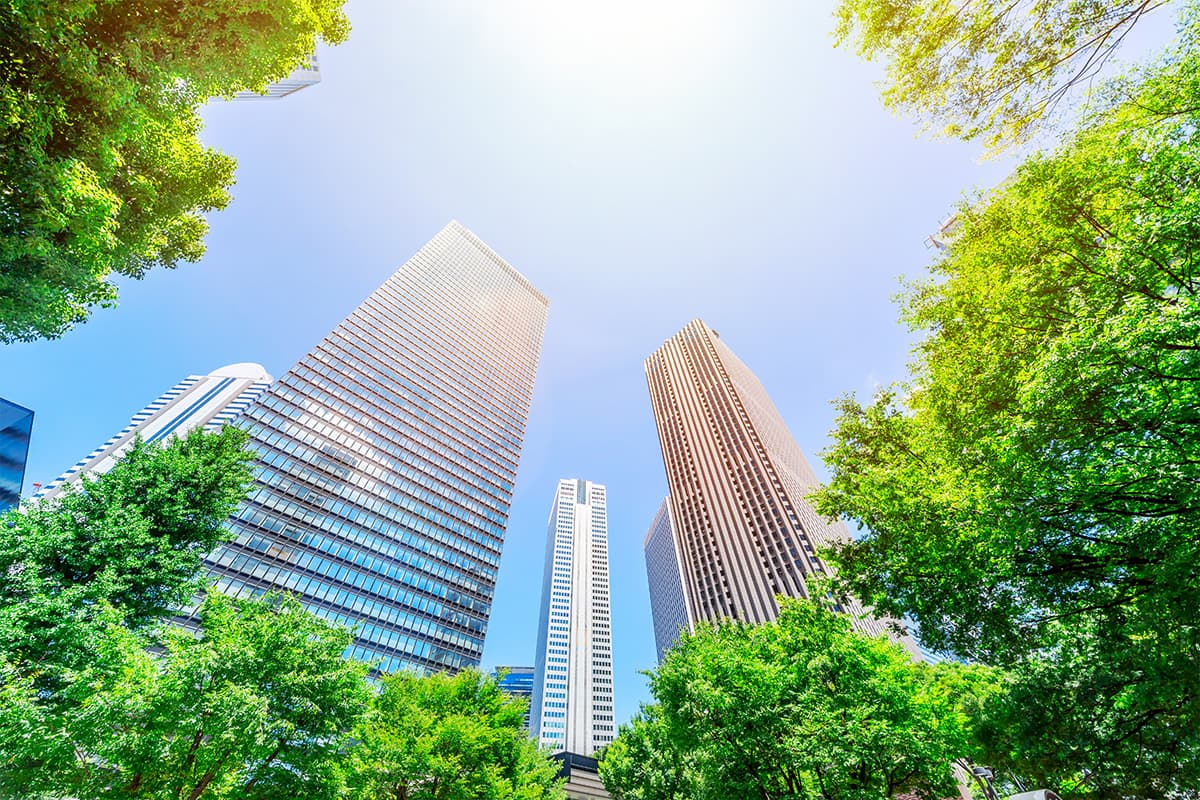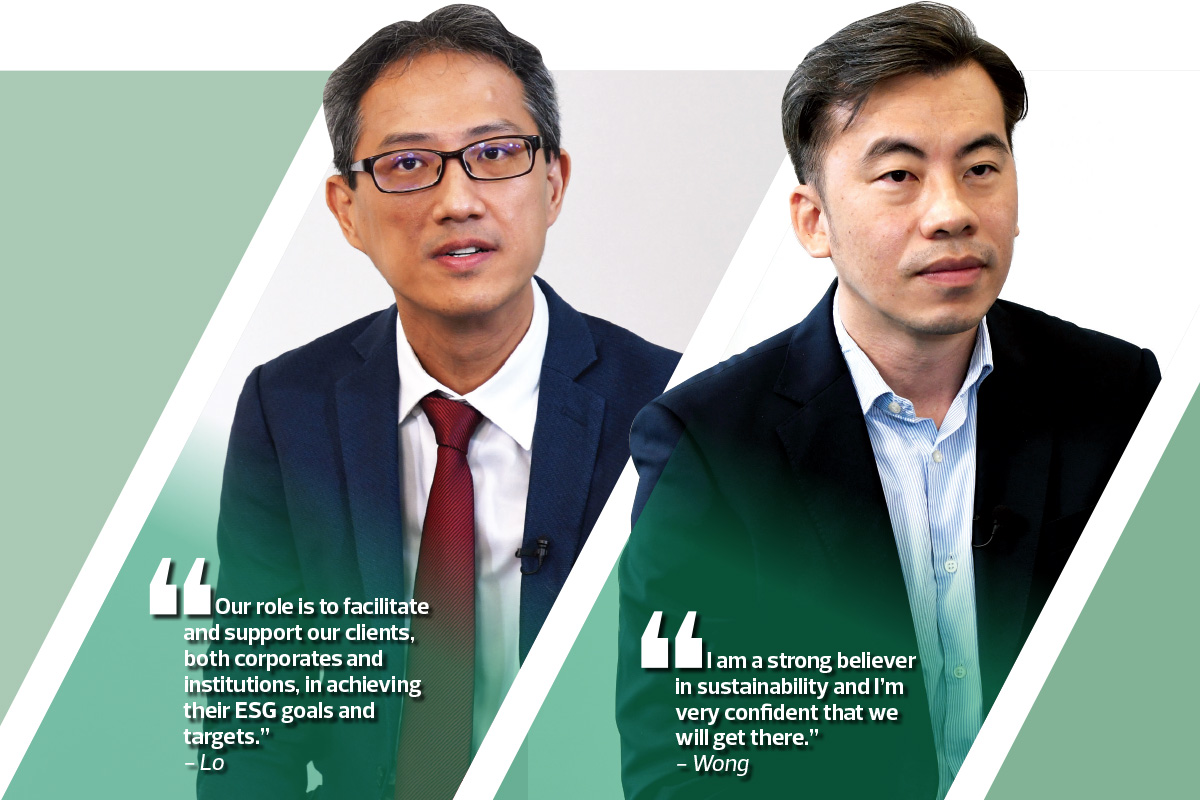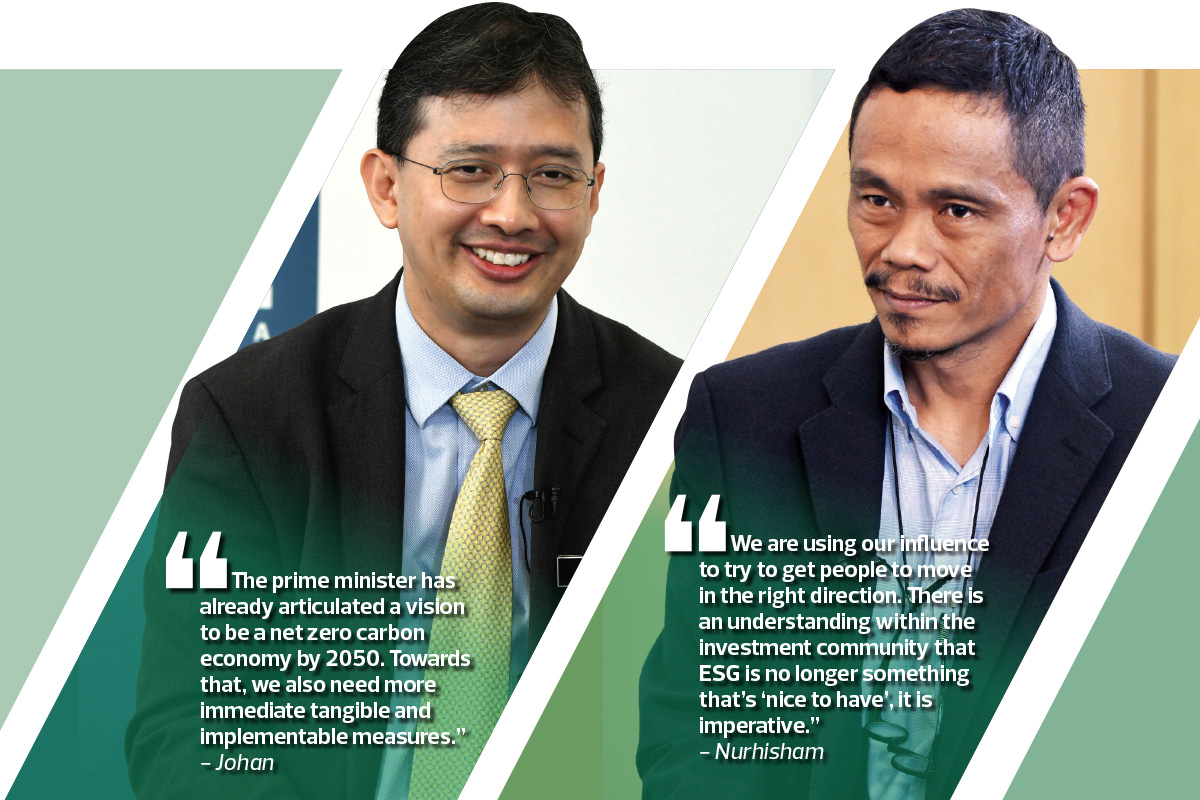
If we have learnt anything in these last couple of years, it is that collaboration is key to achieving sustainability.
The Covid-19 pandemic has been the wake-up call to address the need for more sustainable practices, but the scale, scope and complexity of the economic and social transformation is such that no one stakeholder — government, business or institutional investors — will be able to manage the transformation alone.
Public-private collaboration plays a critical role in unlocking new opportunities and solving existing challenges, say the panellists at the “Creating partnerships: Supporting Malaysia’s sustainability agenda” roundtable organised by BNP Paribas and The Edge Malaysia, moderated by Pathma Subramaniam - editor of Digital Edge.
The panellists were Datuk Johan Mahmood Merican, deputy secretary-general (policy) at the Ministry of Finance; Wong Yin Kee, managing director of ENGIE Services Malaysia; Nurhisham Hussein, chief strategy officer of the Employees Provident Fund (EPF); and Anthony Lo, CEO of BNP Paribas Malaysia Berhad.
Topics included safeguarding human welfare, protecting the biosphere, balancing generational interests, and public participation in decision-making that will define the Covid-19 era.
Below are some highlights from the hour-long discussion:
Sustainable Development Goals (SDGs) are a complex set of challenges and they require every entity to come together. Achieving them requires a lot of collaborative effort. What are the initiatives undertaken by the government and how are businesses adopting sustainability?
Datuk Johan Mahmood Merican: The government has a role to provide leadership through policies, funding or incentives to help build up momentum and catalyse change.
The prime minister has already articulated a vision to be a net zero carbon economy by 2050. Towards that, we also need more immediate tangible and implementable measures. The government will do that through policy, expenditure and tax. In Budget 2022, the federal government has enhanced the ‘ecological fiscal transfer’, which rewards states that maintain green areas to get specific grants, towards reducing reliance on logging income. There is still much more to do on how best to reward or incentivise those that hold back [from logging] and preserve green areas. That is another area to improve on government policies.
Then, in terms of industry, we have something called Green Investment Tax Allowance, to reward those who invest in green technology assets. Bank Negara Malaysia also launched the Business Recapitalisation Facility and the Low Carbon Transition Facility amounting to RM1 billion each to encourage and support small and medium enterprises (SMEs) in adopting sustainable practices for business resilience.
There are quite a few other measures the government has initiated to promote sustainability. Beyond what the government itself does and the incentives for the industry and for the consumer, we need to increasingly approach advancing sustainability through partnership.
Anthony Lo: We (BNP Paribas) are one of the early movers of ESG and we are very glad to see that the institutions and corporates in Malaysia are adopting it. And what’s important is clearly, as a bank, we are excited to be contributing to this transition journey that the country is undertaking.
Our role is to facilitate and support our clients and institutions in promoting and achieving their ESG goals and targets. In this regard, BNP Paribas has joined the Net Zero Banking Alliance launched by the United Nations Environment Programme Finance Initiative. We have also formed a Low-Carbon Transition Group comprising 250 professionals across the globe. Basically, these are people with expertise in advisory, lending, capital markets, risk management and so on dedicated to supporting our clientele. First, we work on understanding their goals and aspirations for sustainability and then figure out their immediate milestones or targets that we can support. And on the back of those requirements, [we] design relevant banking solutions to support the transition journey for the clients.
Nurhisham Hussein: The EPF’s ESG (environment, social and governance) journey started many years ago when we started looking at our investments from an ethical perspective when it was decided that we will not invest in gambling, alcohol and weapons. And then we gradually shifted over to look at the whole spectrum of ESG. We signed on to the UN Principles for Responsible Investment (PRI) in 2019 and we set up our sustainability office just shortly after that. It’s still early days for us but, generally speaking, most of the funds in East Asia are still behind in terms of ESG, relative to Europe and the US, where things are progressing very rapidly.
One thing that we’ve seen, especially in the last couple of years, is that if you are not ESG-compliant, your access to capital may be limited. There’s this question of whether sustainable investments actually provide superior returns, but what we see is, if you’re not ESG-compliant, you may not be able to provide returns at all.
People just won’t invest in you. And, this is not just in public markets; this is also in private markets as well. This is filtering down to the entire financial ecosystem and if you’re not on board, from an investment perspective, there’s not going to be much of foreign interest and your business isn’t going to be able to function because you will have no access to capital.
At the EPF, our target is to be 100% ESG-compliant by 2030. So, every proposal that goes to the investment panel also has to have that ESG assessment. ESG is not going to be a feature anymore — it’s going to be part of the system.
Wong Yin Kee: I’ve been in the energy sector for 20 years and I have seen how fast the sector has transitioned from a high-carbon activity to a low-carbon sector. Two decades ago, ESG was more a theoretical ambition. But today, from a corporate standpoint, we can see that most of the decision-makers know they have to be more sustainable in the way they do business. An energy company, ENGIE’s purpose is to accelerate this energy transition and help our clients in two ways — to get access to green power and green energy supply, and to be more efficient or to reduce energy consumption in their day-to-day business activities.
Malaysia is one of the top carbon dioxide (CO2) emitters in Asean. What are the challenges faced in heading towards carbon neutrality?
Wong: When we talk to clients or our partners about sustainability and ESG, the question we still get asked is: Will it cost me a lot to comply? To them, it’s costly to comply but that was true five to 10 years ago. Today, with all the advancements we have achieved with green technology, I would say that it is profitable to comply.
In all of ENGIE’s projects today, we are generating cost savings for the customers, which has allowed them to comply with their ESG reporting as well. It’s not an extra premium that the business leaders or government sectors have to pay. Green technology is extremely viable now from an investment standpoint.
Johan: It’s an interesting point. For solar prices, back then, the government had to incentivise and subsidise. But now, if we compare prices, we’re reaching tariff parity.
Solar is the cheapest energy source in Malaysia. And if you look at the prices over the last 10 years, solar energy has come down at least 50% already. So, it’s viable today.
We would be encouraging greater adoption of renewables and sustainable practices if we didn’t continue to subsidise fuels indiscriminately.
Nurhisham: The EPF recently converted a sizeable portion of our energy source to solar. But individual companies, [like SMEs], can only do so much. There are some cost savings but they’re doing it on their own. We need to do it on a national level.
Lo: The pace is picking up and the scale is already there. We could do more and government incentives are already [supporting] the development of the ecosystem. For example, Bursa Malaysia [will be introducing] a voluntary carbon credit trading platform, supporting green asset owners and investors.
We also see how regulators [are] coming out with taxonomies, and very recently, Bank Negara and the World Bank published a report titled “An Exploration of Nature-related Financial Risks in Malaysia”. In terms of awareness, we need to understand the implications of these [nature-related] risks and the potential financial or economic concerns that may arise in order for us to identify, measure and mitigate these risks in advance.
I’m quite optimistic and glad to see the level of awareness that has been built by the stakeholders in the ecosystem and the community. What we need to do better [at] is to raise the bar in terms of bringing that awareness not just at the corporate level but also to the community at large.
What will it take to get businesses to go from “brown” to “green”?
Lo: For economies in transition, financial institutions can provide support to help these large enterprises reinvent themselves. It is these players across ‘brown’ industries that have the most potential to drive the largest reduction in carbon. For example, we provided financing as well as hedging solutions to support large-scale solar (LSS) projects in Malaysia, and they have been quite successful.
BNP Paribas’ asset management is the investment arm of the bank and has been a major global player in sustainable investment since 2002. We are honoured to accompany our partners such as EPF in terms of their ESG and climate-related investments. We are also a part of the Joint Committee on Climate Change (JC3) by Bank Negara and the Securities Commission Malaysia, where financial intermediaries are part of the committees formulating and collaborating on specific action plans to work on transition plans for the country.
At the local level, we are part of the CEO Action Network (CAN), an active network of leading Malaysian businesses pursuing open dialogues on the issues we are facing, how to [go] about addressing them, and what we can do more to help our stakeholders and clients to transition to become more sustainable.
Nurhisham: The EPF, for our sustainable investment policy, did a deep dive into six sectors, namely oil and gas, palm oil, mining, power generation, construction and banking [to focus on] at the moment and we will be adding more along the way. Based on a materiality assessment that we conducted, the six priority sectors were identified premised on our exposure and the ESG risks prevalent in the sector. We identified what’s important in those sectors and then set expectations of what we wanted to see.
We’ve done multiple engagement rounds with them to find out their plans, say, for the next 10 years, [which is] until 2030, and the challenges they are facing.
For certain sectors, like energy, the transition is going to take longer. But what we want to see is progress: Are you heading in the right direction? Are you meeting the benchmarks that we have set along the way? What are the milestones that you need to achieve?
And, we are using our influence to try to get people to move in the right direction. There is an understanding within the investment community that ESG is no longer something that’s ‘nice to have’, it is imperative.
Wong: If you look at energy demand usage in cities, for example, it’s going to double by 2030. Because of rapid urbanisation, people are getting wealthier and cities would tend to use more and more energy. With this increasing demand, there will be more incentives for companies to come up with new technology. Batteries will be cheaper and EVs will be cheaper too. In this demand versus supply scenario, I can foresee that there will be more and more new green technologies in the market.
As there are more millennials and Gen Z who are now working, do you see a lot more push from them for the EPF to provide more sustainable fund options?
Nurhisham: What we’ll be doing is giving [members] a choice. So, come the end of the year, we hope to be able to launch a green fund where our members will be allowed to allocate their funds to a sustainability fund.
I think it’s important to provide that option. If you really care about [ESG], then you [will] have this option. At the moment, the focus is still on returns, at least for the majority of our members. But as the demographic of our members changes, that may change as well.
Eventually what will happen is that if you’re not ESG-compliant, you may not get the capital and investors in that area may not get their returns.
Johan: One thing that we learnt from the recent Covid-19 crisis is how vulnerable millions of Malaysian households are when there’s a shock to the economy [that they have to depend on their] life savings to tide them over.
On a broader scale, we have to gradually increase income. To do that, we’re going to have to drive productivity gains. This in turn raises the question of: How are we going to accelerate adoption of digitalisation and automation to achieve this? And with that, in the event of a shock, we need better social protection. We’ve seen more and more people in the gig and informal economy, so how do we provide a social protection system that also covers them?
We need these pieces of jigsaws in place — better income and better social protection — so that we are better able to transition to a more sustainable economic model including better market pricing for various resources.
Now, if all these suggestions are implemented, can we avoid an apocalyptic future? Will adopting ESG standards be the panacea the world needs?
Johan: I can’t see too far ahead for the world but when it comes to sustainability, the government today is committed. It’s a core part of our economic development policy. It is not just about growth and inclusiveness but also about sustainability.
As we strengthen our recovery this year, we need to increasingly look at reform and certainly one key area is targeted subsidies, particularly in terms of fuel towards ensuring a more sustainable consumption economy. But a lot of this does require greater acceptance, maybe in terms of education and change management for both the rakyat and industries to embrace some of these reforms. But that’s certainly the direction that the government is committed to.
Lo: I’m optimistic about the future. There’s more that we need to do but the awareness is growing and stakeholders are all moving in the right direction. All of us here today are representatives of our respective industries contributing to the country’s sustainability agenda.
One of the things that we are quite humble about is the kind of trust that our clients and stakeholders place on us. For example, BNP Paribas was awarded World’s Best Bank for Sustainable Finance 2021 by Euromoney. And that’s thanks to the trust that our clients and stakeholders place in us in actually supporting them in their sustainable transition journey. And that’s exactly what we want to do and continue to promote in Malaysia.
Nurhisham: We need collective action on a global basis and I think a lot of people are working towards that.
Eventually, sustainability will become an aspect of life that’s no longer going to be a fad but something you’re going to think about all the time; it will be embedded in our culture. We’re not there yet — it will take a lot of effort and it will take a lot of education but we are getting there. And I think there’s a lot of awareness, a lot of people are acting on sustainability. And that’s the part where it’s encouraging, but we are running against time.
The best we can do is mitigate the impact because we’re not going to [be able to] reverse it. So, we have to look at what the potential risks are from climate change — flood risk and sea level rise. Basically, have a realistic view of what’s likely to happen over the next 10 years and figure out how to mitigate that.
Wong: I am a strong believer in sustainability and I’m very confident that we will get there. ENGIE has been at the forefront of energy transition globally, there’s no question about our ambitions. We are in an unprecedented era and we will see a boom in sustainability and green solutions — that’s my view.
At the country level, the government has a strong ambition to be carbon neutral by as early as 2050. The renewable energy mix will be 31% by 2025 in terms of power generation mix. There is also another target, which is to reduce greenhouse gas emission intensity by 45% in 2030.
And, efforts by the government such as the Green Investment Tax Incentives are encouraging investors to put their money into sustainable solutions.
At the industry level, where the highest energy consumers are, there’s also strong traction towards sustainability. These industry players want to look at how they can be more efficient and sustainable in their energy usage.If we work together, there’s a chance of winning the fight against climate change and achieving sustainability.


